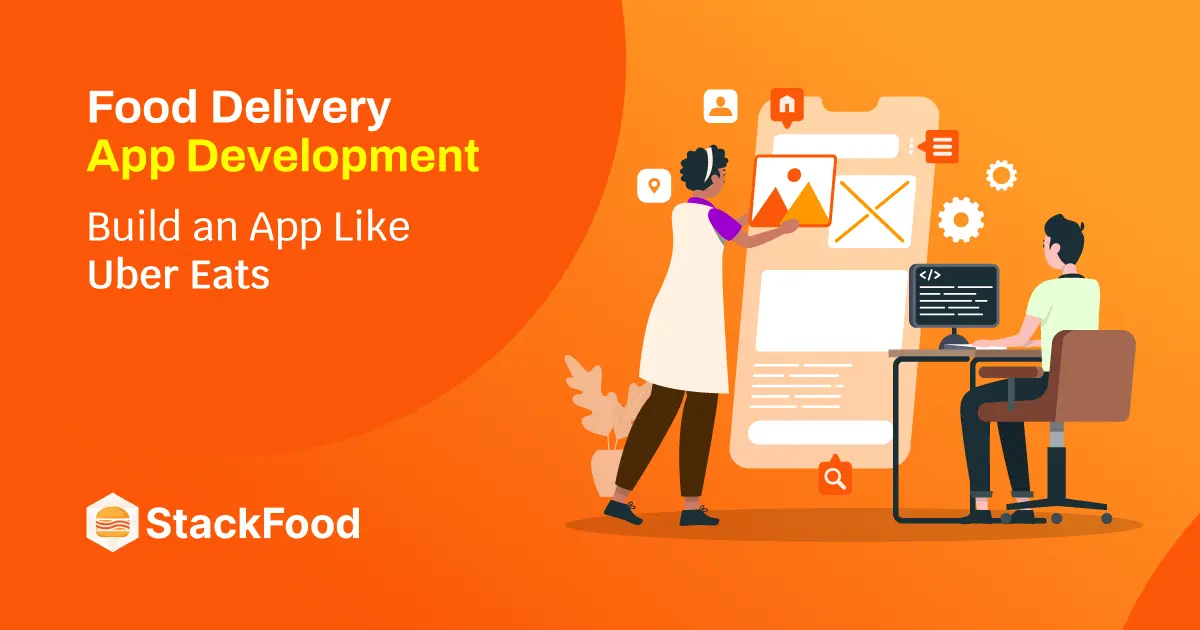With the rising popularity of food delivery apps like Uber Eats – businesses nowadays can’t think of being in the market without launching an app. And the duty & possibilities of food delivery app developers have increased along the way.
If you’re a developer who wants to create an app like Uber Eats – you’ve landed in the right place. In this blog, I will share a step-by-step guide on building a market-leading app like Uber Eats for your client project.
From this blog, you will get to know about:
- A model or workflow of how Uber Eats and similar food delivery apps works
- Step-by-step guide on building an app like Uber Eats
- Must-have features of a food delivery app
- A complete solution to make your next client project work easier
So without any further delay, let’s get started!
The Workflow of A Food Delivery App like Uber Eats
Apps like Uber Eats connect stakeholders such as customers, restaurants, and delivery persons. For a better understanding, the workflow is presented below:
User Registration: Users sign up and create accounts on the app.
Browse Restaurants: Users browse nearby restaurants and menus.
Place Order: Users select items from the menu and place orders.
Payment: Users make payments securely through the app.
Order Confirmation: Restaurants receive orders and confirm them.
Order Preparation: Restaurants prepare the food for delivery.
Delivery Request: Delivery drivers receive requests to pick up orders.
Pickup: Drivers pick up orders from restaurants.
Delivery: Drivers deliver orders to users’ locations.
Order Completion: Users receive their orders and complete the transaction.
Explore: Online Food Delivery Software and App Projects Live Demo
Step-by-Step Guide on Building An App Like Uber Eats
For a competent developer like you, this section serves as a roadmap to make your food delivery app-building journey easier. A clear roadmap like this will help you go through every necessary step that can’t be excluded while developing an app like Uber Eats. So, it’s time to flex the coding muscles and leave the hassles behind.
Step 1: Research & Planning
To identify and define your focus, method, and goals with your food delivery app, you must do competitor research and plan accordingly. Proper market research can uncover important facts, help you understand the gaps in the market that can be implemented in your app, and understand the trends between the target audience and app users.
For research and planning, try to identify the following:
- Your target audience
- Needs of the target audience
- Preferences of your target audience
- Features that are unique and not available in the market
- Functionality and design of your app
Step 2: Pick The Right Food Delivery Model
Choosing a food delivery model can help you meet your goals with the application as well as meet the needs of the prospective users of it. There are 3 kinds of food delivery models you can choose from-
- Order-only model
- Order and delivery model
- Integrated model
Step 3: Define Your Unique Selling Proposition (USP)
To define your unique selling proposition, ask questions like –
- What gap or need in the market does my app address?
- What makes my app stand out from existing food delivery apps?
- How will my app provide a better user experience compared to competitors?
- What unique features or functionalities can my app offer to attract and retain users?
The answers to these questions would be why people would use your food delivery app over the competitors. It will help you gain a competitive advantage and set your app apart from the existing ones.
Step 4: Choose The Right Technology Stack
You need to choose the right technology stack to run your app smoothly, efficiently, and reliably. A wrong technology stack can make all your efforts go in vain, but the right one can –
✅ Speed up the total development process
✅ Improve the overall performance of your app
✅ Ensure security
✅ Scale the progress
The table below shows the tech stack that can be used to build a food delivery app like Uber Eats-
| Aspect | Technologies |
| Front-end | HTML, CSS, JavaScript, React.js, Redux, GraphQL |
| Back-end | Programming Language (Python, Ruby, Java), Web Framework (Django, Rails), Database Management System (MySQL, PostgreSQL) |
| Platform | iOS SDK, Android SDK, Programming Languages (Objective-C, Swift, Java, Kotlin) |
| Hosting | Linux, Apache, Amazon Web Services (AWS) |
| Infrastructure | Kafka, Apache Cassandra, PostgreSQL |
Table: Technology stack for food delivery app development
Step 5: Design Your Food Delivery App
In this step, you need to create wireframes and mockups to create a visualization layout and user interface. Keeping it simple and intuitive is the key to a better user experience.
To design your app, you can use various tools such as Adobe XD, Sketch, or Figma. These tools offer user-friendly interfaces and drag-and-drop functionality. These tools don’t require extensive coding knowledge and are designed to be accessible to beginners.
In your design process, ensure that each step is clear and intuitive, with easily identifiable buttons and navigation elements. You need to pay attention to –
- Hierarchy
- Color schemes
- Typography
Thinking about where to find inspiration? Well, you can find inspiration from existing apps and websites. Additionally, websites like Dribble and Behance showcase design portfolios from professionals around the world, where you can find a wealth of inspiration and ideas.
Step 6: Develop Backend Infrastructure
Now, it’s time to build the backbone of your food delivery app. In this stage, you will have to handle tasks like user registration, processing orders, handling payments, notifications, etc.
You will have to focus on the scalability and reliability of your app so that it can handle growth and provide a reliable experience to its users.
It is important to have a strong backend infrastructure to make your app dynamic and useful. As the developer, you will manage the database, apply business logic, ensure security, and perform backups.
While developing the backend, you will be working with programming languages like Python, JavaScript, Ruby, etc. Also, you will have to use cloud services like Amazon Web Services (AWS) or Google Cloud Platform (GCP). As it is the foundation of your app’s success, using the right technology and scaling your infrastructure is a must.
Step 7: Develop Frontend Interface
As the name suggests- it’s at the forefront of your application that manages the user interface. It combines design and backend data to create an interactive user interface for the application. The users of the application will directly interact with this part.
To maintain the consistency of all your mobile app screens, use the same fonts, colors, and layout patterns throughout it. It will help the users feel comfortable and make their journey enjoyable. Each screen should be easy to navigate and understand, with clear labels and intuitive controls.
You will have to work with libraries and SDKs like React.js and Flutter to develop your front end. Using these will make it easier for you to build responsive and interactive interfaces. The advantage is you will get plenty of resources and tutorials to help you get started with these.
Step 8: Test and Ensure Quality
It’s important to thoroughly test to ensure your app works as intended and provides a seamless experience.
For this, you can check using different devices and platforms like iOS and Android. Also, test under different network speeds, and device capabilities.
Ensure you covered all types of testing in this phase:
- Functional Testing
- Usability Testing
- Compatibility Testing
- Performance Testing
- Security Testing
If you find any bugs or issues during tests, like broken links, missing features, or unexpected behavior, make sure to resolve or improve them before launching or handling the project to your client.
By conducting thorough testing and quality assurance, you can ensure your app meets the highest quality standards and provides a great user experience.
Also Read: How To Build an Online Food Delivery Marketplace?
Key Features of a great food delivery app
Knowing the must-have features of a food delivery app would make your development journey easier. If you have a vast idea about what to include and what not to include in your food delivery app like Uber Eats you will be able to deliver the best project out there.
| Customer App | Deliveryman App | Restaurant/ Partner App |
| 1. Registration and Login 2. Search and FIltration 3. Schedule Orders 4. Delivery Tracking 5. Deals and Promotions 6. Multiple and Secure Payment Options 7. Social Media Login 8. Profile Customization 9. Push Notification 10. Ratings and Reviews 11. Customer Profile 12. Customer Wallet 13. Live Chat 14. Location Setup | 1. Register as a deliveryman 2. Track Earnings 3. Live Chat 4. Push Notifications 5. Order Request 6. Order History 7. Incentives 8. Profile Settings 9. Detailed Dashboard | 1. Dashboard 2. Food Management 3. Promotion Management 4. Deliveryman Management 5. Order History 6. Food Reviews 7. Live Chat 8. Expense Report |
Table: Key features of a great food delivery app like Uber Eats
How Can StackFood Help Launch Your Food Delivery Business?
I have a great thing to share with you in this section of the blog. If you don’t want to take the hassle of building a food delivery app from scratch – there’s a readymade solution for you.
It’s StackFood – the ultimate multi-restaurant delivery solution that comes with all the up-to-date, trending, yet necessary web panels and applications that can help you scale your next project. With StackFood, you’re not only getting the food delivery app but also apps and panels for every stack holder of the system. It comes with –
- Customer App
- Flutter Web App
- Admin Panel
- Restaurant Panel
- Restaurant App
- Deliveryman App
- React Website
So you’re getting a complete package without the need of developing it from basic. Now, if you’re wondering if the solution doesn’t come with one specific feature that you need, then be assured that it was built after extensive market research with unique value propositions, yet if you feel like you need to change, edit, or add any feature, you can always ask for assistance from their support team.
Final Words
As explained in this blog, you now have a complete idea of how to build a food delivery app similar to Uber Eats. It’s not about copying what the industry leaders are doing, but it’s about taking inspiration from them and incorporating your own research into the app development process to make it unique and distinctive.
That’s all for today. I hope to see you in the next blog!
FAQs
What security measures should be taken for a safe food delivery app?
Encrypting sensitive information and securing connections between apps and servers, along with two-factor authentication and routine audits, can ensure high protection for user data and transactions in a food delivery app.
How do food delivery apps verify user identity?
In your food delivery app, users verify their identity through email or phone number and a password, called authentication. Once authenticated, the app determines user permissions, or authorization, dictating what actions they can perform.
Meet Mehrin! A technical writer with a Computer Science background. She combines her academic knowledge & creativity to transform complex facts into engaging content. With a sharp eye for detail, she keeps readers updated on tech trends. Outside of writing, she’s a visual storyteller, capturing life’s moments through photography.







